Physical Science Paper 2 Grade 12 Questions - NSC Past Papers And Memos September 2020 Preparatory Examinations
Share via Whatsapp Join our WhatsApp Group Join our Telegram GroupINSTRUCTIONS AND INFORMATION
- Write your full NAME and SURNAME in the appropriate spaces on the ANSWER BOOK.
- This question paper consists of SEVEN questions. Answer ALL the questions in the ANSWER BOOK.
- Start EACH question on a NEW page in the ANSWER BOOK.
- Number the answers correctly according to the numbering system used in this question paper.
- Leave ONE line between two sub questions, for example between QUESTION 2.1 and QUESTION 2.2.
- You may use a non-programmable calculator.
- You may use appropriate mathematical instruments.
- Show ALL formulae and substitutions in ALL calculations.
- Round off your FINAL numerical answers to a minimum of TWO decimal places.
- Give brief motivations, discussions, et cetera where required
- You are advised to use the attached DATA SHEETS.
- Write neatly and legibly.
QUESTIONS
QUESTION 1: MULTIPLE-CHOICE QUESTIONS
Various options are provided as possible answers to the following questions. Choose the answer and write only the letter (A–D) next to the question numbers (1.1–1.10) in the ANSWER BOOK, for example 1.11 D.
1.1 Which ONE of the following factors will increase the rate of a chemical reaction by offering an alternative path of lower activation energy?
- Pressure
- Temperature
- Surface area
- Positive catalyst (2)
1.2 Structural isomers always have the same …
- carbon chain.
- functional group.
- molecular formula.
- physical properties. (2)
1.3 Which ONE of the following has the HIGHEST vapour pressure?
- Pentane
- Hexane
- Heptane
- Octane (2)
1.4 Which ONE of the following is the structural formula for the functional group of ethanoic acid?
(2)
1.5 Consider the chemical reaction given below:
X + concentrated H2SO4 → CH3CHCHCH3 + H2O
Which ONE of the following is CORRECT about reactant X?
Reactant X is a …
- tertiary alcohol.
- primary alcohol.
- secondary alcohol.
- primary haloalkane. (2)
1.6 The potential energy diagram shown below is for the hypothetical reversible reaction shown below.
X2(g) ⇌ Y2(g)
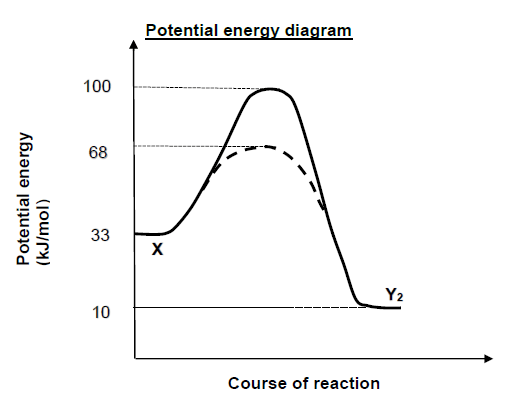
The value of ΔH (in kJ/mol) for the catalysed forward reaction is equal to …
- 23
- -23
- 58
- -58 (2)
1.7 The reaction represented by the balanced equation below reaches equilibrium in a closed container.
C(s) + CO2(g) ⇌ 2CO(g)
More C(s) and CO2(g) are added to the container at constant temperature.
How will the number of moles of CO(g) and the value of Kc be affected at equilibrium?
NUMBER OF MOLES OF CO | Kc | |
A | Increases | Increases |
B | Increases | Remains constant |
C | Remains the same | Remains the same |
D | Remains the same | Increases |
(2)
1.8 The relationship between [H3O+] and [OH-] in an aqueous solution at constant temperature is best represented by …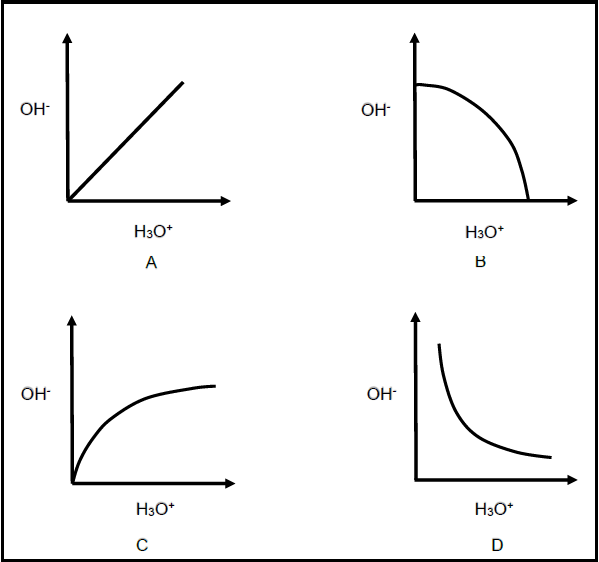
(2)
1.9 Gaseous chlorine (Cℓ2), used to disinfect water in public swimming pools reacts with water according to the following balanced equation.
Cℓ2 + H2O → HOCℓ + HCℓ
The addition of chlorine changes the pH of water in swimming pools.
Which ONE of the following substances must be added to public swimming pools periodically to increase the pH?
- KCℓ
- NH4Cℓ
- H2SO4
- Na2CO3 (2)
1.10 Consider the reaction in which magnesium powder reacts with EXCESS 50 cm3 of a 0,1 mol∙dm-3 of sulphuric acid solution.
Mg(s) + H2SO4(aq) → MgCl2 (aq) + H2(g) ΔH < 0
Which ONE of the following changes will increase the rate of production of hydrogen gas?
- Increase in pressure.
- Heating the reaction mixture.
- Using 100 cm3 of the same acid solution.
- Adding water to the reaction mixture. (2)
[20]
QUESTION 2 (Start on a new page.)
Consider compound A which is a member of homologous series of saturated hydrocarbons.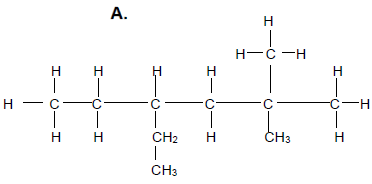
2.1 Define the term homologous series. (2)
2.2 Give a reason why compound A is classified as a hydrocarbon. (2)
2.3 For compound A write down the:
2.3.1 General formula of the homologous series to which it belongs (1)
2.3.2 IUPAC name (3)
2.4 Consider compounds P and Q shown below:
P: 2-methyl-2-propanol Q: 
Write down the:
2.4.1 Structural formula of compound P (2)
2.4.2 IUPAC name of a FUNCTIONAL isomer of compound Q (2)
2.4.3 Give a reason why compound Q CANNOT have a POSITIONAL isomer. (1)
2.5 Polyethene is produced when many ethene monomer units join together to form a polymer according to the equation:![]()
2.5.1 Write down the type of reaction described by the underlined phrase. (1)
2.5.2 Give a reason why polyethene is regarded as saturated. (1)
2.5.3 Name ONE use of polyethene. (1)
[16]
QUESTION 3 (Start on a new page.)
The boiling points shown in the table were obtained during an investigation into the boiling points of compounds A, B and C. The compounds have a comparable molecular mass.
| Compound | Boiling point (°C) | |
| A | Hexane | 68 |
| B | Pentanal | 103 |
| C | Pentan-2-ol | 119 |
3.1 Define the term boiling point. (2)
3.2 Give a reason why the compounds used in the investigation must have a comparable molecular mass. (1)
3.3 Explain the difference in boiling points of compound A and B by referring to the TYPE and STRENGTH of intermolecular forces and energy involved. (4)
3.4 How will the vapour pressure of a CHAIN isomer of compound C compare to that of compound C?
Write down only HIGHER THAN, LOWER THAN or SAME AS. (1)
3.5 Explain the answer in QUESTION 3.4 by referring to MOLECULAR STRUCTURE and TYPE of INTERMOLECULAR FORCES. (3)
3.6 Using MOLECULAR FORMULAE write down a balanced equation for the complete combustion of hexane. (3)
[14]
QUESTION 4 (Start on a new page.)
Consider the THREE incomplete organic reactions below.
- : 2-bromobutane + dilute NaOH →
- : Compound P + H2 → CH3CH(CH3)CH3
- : CH3CH2CH2COOH + CH3CH2CH2OH → Ester + Q
4.1 For reaction I write down the:
4.1.1 Type of reaction taking place (1)
4.1.2 IUPAC name of the organic product formed (2)
The dilute sodium hydroxide in reaction I is replaced with concentrated sodium hydroxide and the reaction mixture is strongly heated.
4.2 Write down a balanced equation for the reaction taking place when concentrated sodium hydroxide is used in reaction I using STRUCTURAL FORMULAE.
(Ignore the MINOR product.) (6)
4.3 For reaction II write down the:
4.3.1 Name of the type of addition reaction taking place (1)
4.3.2 Name of the catalyst used (1)
4.3.3 Structural formula for compound P (2)
4.4 Consider reaction III.
Write down:
4.4.1 The name of the type of reaction taking place (1)
4.4.2 ONE reaction condition (1)
4.4.3 Name or formula of inorganic product Q (1)
4.4.4 The structural formula and IUPAC name of the ester produced (4)
[20]
QUESTION 5 (Start on a new page.)
A factor influencing the rate of a chemical reaction is investigated by carrying out two experiments 1 and 2 in which the following reaction takes place.
CaCO3 (s) + 2 HCℓ (aq) → CaCℓ2 (aq) + H2O (ℓ) +CO2(g)
In both experiments chunks of pure calcium carbonate (CaCO3) of the same mass are added to EXCESS hydrochloric acid solution (HCℓ) in OPEN flasks. One reaction condition is changed in experiment 2.
Each flask is placed on a mass scale as shown in the diagram below.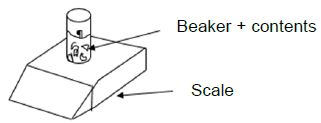
The graph below shows the changes in mass of the beaker and its contents during the reaction in experiments 1 and 2.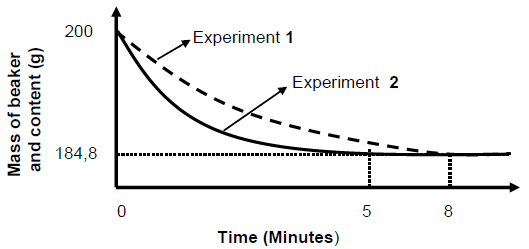
5.1 Define reaction rate in words. (2)
5.2 Write down the FORMULA or NAME of the substance responsible for
the decrease in mass of the beaker and its contents as the reaction proceeds. (1)
5.3 Write down ONE other apparatus needed to measure the rate of reaction besides the scale balance for the above experiments. (1)
5.4 Calculate the average rate of reaction in g∙min-1 for experiment 2. (3)
5.5 Calculate the mass of calcium carbonate that was used in experiment 1. (6)
5.6 The Maxwel-Boltzman distribution curves for the reaction in experiments 1 and 2 are given below.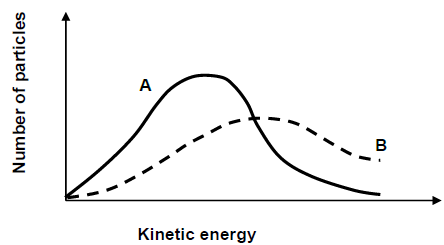
5.6.1 Which factor affecting reaction rate is investigated? (1)
5.6.2 Which curve (A or B) represents the reaction in experiment 2? (1)
5.6.3 Explain the answer to QUESTION 5.6.2 by referring to the collision theory. (3)
5.7 In a second investigation a third experiment (experiment 3), is carried out in which HCℓ of HIGHER CONCENTRATION is used. All the other conditions remain the same in experiment 3 as in experiment 1.
5.7.1 Write down an investigative question for the second investigation, in which experiment 3 is compared to experiment 1. (2)
How do the following quantities in experiment 3 compare to experiment 1? Write down LOWER THAN or HIGHER THAN or EQUAL TO.
5.7.2 Time for the reaction taken to reach completion. (1)
5.7.3 Amount of CO2 that is produced. (1)
5.8 Give a reason for the answer in QUESTION 5.7.3 above. (2)
[24]
QUESTION 6 (Start on a new page.)
Consider the reversible reaction taking place in a closed container:
H2(g) + I2(g) ⇌ 2 HI(g)
6.1 Define the term reversible reaction. (2)
The graph below shows the changes in the amount of the substances H2, I2 and HI from the moment the reactants are pumped into an empty container.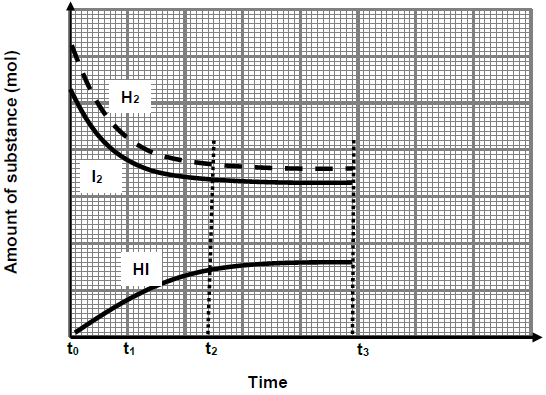
6.2 Which reaction (FORWARD or REVERSE) has a HIGHER rate of reaction during the interval t0 to t1? (1)
6.3 Did the chemical reaction stop during the interval t2 to t3? Write only YES or NO. Give a reason for the answer. (3)
At time t3 the pressure on the equilibrium system is increased by decreasing the volume at constant temperature.
6.4 How will the increase in pressure affect the following?
Write down only INCREASES, DECREASES or REMAINS THE SAME.
6.4.1 Rate of reaction. (1)
6.4.2 Number of moles of HI. (1)
6.4.3 Concentration of HI. (1)
6.5 Explain the answer to QUESTION 6.4.3 above. (2)
6.6 The table below shows the equilibrium constants, Kc values for the reaction at different temperatures.
| TEMPERATURE (°C) | Kc |
| 448 | 50,3 |
| 227 | 129 |
6.6.1 Is there a HIGH or LOW YIELD at 227 °C? Give a reason for the answer. (2)
6.6.2 Is the forward reaction EXOTHERMIC or ENDOTHERMIC? Explain the answer by referring to Le Chatelier’s principle. (4)
6.7 The reaction is started by placing hydrogen gas (H2) and iodine gas (I2) into an empty 0,5 dm3 container which is then sealed and heated.
When the reaction reaches equilibrium at 448 °C it is found that the concentration of H2 and I2 are 0,46 mol.dm-3 and 0,39 mol.dm-3 respectively.
The value of the equilibrium constant, Kc is equal to 50,3 at 448 °C.
Calculate the:
6.7.1 Concentration of HI at equilibrium (4)
6.7.2 Percentage yield at 448 °C (7)
[28]
QUESTION 7 (Start on a new page.)
7.1 Study the following reactions which show the step-by-step ionisation reaction of phosphoric acid (H3PO4).
- H3PO4 + H2O ⇌ H2PO4 + H3O+ Ka = 7,5 × 10-3
- H2PO4 + H2O ⇌ HPO42 + H3O+ Ka = 1,3 × 10-12
7.1.1 Define an acid according to Lowry-Bronsted model. (2)
7.1.2 Write down the formula of the substance that acts as an ampholyte in reaction I and II. (1)
7.1.3 Give a reason for the answer in QUESTION 7.1.2 above. (2)
7.1.4 Which substance, H2PO4 or HPO42 , will have a HIGHER Kb value? Give a reason for your answer. (3)
7.2 Consider the hydrolysis of the ion C2HO4 represented by the balanced equation below.
C2HO4 (aq) + H2O(ℓ) ⇌ C2H2O4 + OH
7.2.1 Define the term hydrolysis. (2)
7.2.2 Write down the conjugate base of C2H2O4. (2)
7.2.3 Give a reason by referring to substance(s) in the equation why the hydrolysis of C2HO4 produces an ALKALINE solution? (2)
7.3 A group of learners perform a titration to determine x number of moles of water of crystallisation in hydrated oxalic acid (C2O4H2 ∙x H2O).
They first prepared a solution of hydrated oxalic acid, by adding 7,56 grams of hydrated oxalic acid to water and made a volume of 250 cm3 solution.
During a titration 25 cm3 of the solution of hydrated oxalic acid is neutralised by exactly 24 cm3 of a 0,5 mol∙dm-3 solution of sodium hydroxide according to the balanced equation:
C2O4H2. x H2O(s) + 2 NaOH(aq) → C2O4Na2(aq) + (x+2) H2O(ℓ)
(Water of crystallisation does not react with the base.)
7.3.1 Define a strong base. (2)
7.3.2 Calculate the pH of the 0,5 mol∙dm-3 sodium hydroxide solution. (5)
7.3.3 Determine the value of x by calculation. (7)
[28]
TOTAL: 150
DATA FOR PHYSICAL SCIENCES GRADE 12
PAPER 2 (CHEMISTRY)
TABLE 1: PHYSICAL CONSTANTS
| NAME | SYMBOL | VALUE |
| Standard pressure | pθ | 1,013 x 105 Pa |
| Molar gas volume at STP | Vm | 22,4 dm3∙mol-1 |
| Standard temperature | Tθ | Tθ 273 K |
| Charge on electron | e | -1,6 x 10-19 C |
| Avogadro’s constant | NA | NA 6,02 x 1023 mol-1 |
TABLE 2: FORMULAE
n = m | n = N NA |
| c = n V or c = m MV | n = V Vm |
| caVa= na cbVb nb | pH= -log[H3O+] |
| Kw = [H3O+][OH-] = 1x10-14 at 298K | |
| Eθ cell = Eθ cathode – Eθ anode Eθ cell = Eθ reduction – Eθ oxidation Eθ cell = Eθ oxidising agent – Eθ reducing agent |
